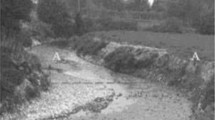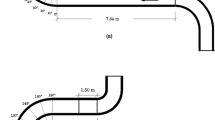Abstract
Eco-friendly low-head river restoration structures such as block ramps are of paramount importance with regard to the control of sediment grade in rivers, particularly in the mountains. They also help in the stabilization of river bed and prevent damages due to excessive downstream erosion by dissipating flow energy. Although the hydraulic characteristics of block ramps in straight channels have been thoroughly studied, there are very less studies dealing with the analysis of scour mechanism downstream of block ramps in curved channels. In fact, to the authors’ best knowledge, there are no studies till date investigating the scour process downstream of block ramps in river bends, involving the effect of tailwater and ramp bed slope. Therefore, this study aims to analyze the hydraulic behaviour of block ramps placed at various positions on a curved channel incorporating the effects of the mentioned parameters. Furthermore, the equilibrium morphology of the resulting downstream scour has been analyzed and classified. A dedicated hydraulic model was constructed, and a large range of in situ hydraulic conditions were simulated. Tests were carried out varying ramp slope and locating the structure at different positions along the channel bend. Data analysis revealed that the scour morphology is essentially three-dimensional and depends on flow characteristics, tailwater level and slightly on its location. Finally, a useful design relationship was also developed to evaluate the maximum scour depth taking into consideration the effect of channel curvature and the tailwater level.










Similar content being viewed by others
Abbreviations
- B :
-
Channel width
- d xx :
-
Size of bed material for which xx% is finer
- f :
-
Function of
- Fd :
-
Densimetric Froude number
- \({\dot{\text{F}}}\) d90 :
-
Equivalent densimetric Froude number for curved channels
- g :
-
Gravitational acceleration
- g′:
-
Reduced gravitational acceleration
- h 1 :
-
Approach flow depth at ramp toe
- h 0 :
-
Downstream tailwater depth
- l 0 :
-
Scour length
- Q :
-
Discharge
- S 0 :
-
Block ramp slope
- V 1 :
-
Average approach flow velocity at the ramp toe
- x :
-
Longitudinal coordinate
- z :
-
Vertical coordinate
- z max :
-
Maximum scour depth
- z max(t=2 h) :
-
Maximum scour depth after 2 h from the beginning of the test
- z max(t=6 h) :
-
Maximum scour depth after 6 h from the beginning of the test
- z M :
-
Maximum ridge height
- Z m :
-
Non-dimensional scour depth in straight channels
- Z msc :
-
Non-dimensional scour depth in curved channels
- R :
-
Radius of curvature of the channel
- α :
-
Location of the block ramp in the curved channel
- Π i :
-
ith non-dimensional group
- ρ :
-
Water density
- ρ s :
-
Sediment density
- σ :
-
Sediment non-uniformity parameter
- Ψ i :
-
ith re-arranged non-dimensional group
References
Adduce C, Rocca M (2006) Local scouring due to turbulent water jets downstream of a trapezoidal drop: laboratory experiments and stability analysis. Water Resour Res 42:W02405. https://doi.org/10.1029/2005WR004139
Bombardelli FA, Palermo M, Pagliara S (2018) Temporal evolution of jet induced scour depth in cohesionless granular beds and the phenomenological theory of turbulence. Phys Fluids 30:1–19. https://doi.org/10.1063/1.5041800
Bormann E, Julien PY (1991) Scour downstream of grade control structures. J Hydraul Eng 117(5):579–594. https://doi.org/10.1061/(ASCE)0733-9429(1991)117:5(579)
Breusers HNC, Raudkivi AJ (1991) Scouring. IAHR hydraulic structures design manual. Balkema, Rotterdam
D’Agostino V, Ferro V (2004) Scour on alluvial bed downstream of grade-control structures. J Hydraul Eng 130(1):1–14. https://doi.org/10.1061/(ASCE)0733-9429(2004)130:1(24)
Dey S, Raikar RV (2005) Scour in long contractions. J Hydraul Eng 131(12):1036–1049. https://doi.org/10.1061/(ASCE)0733-9429(2005)131:12(1036)
Dey S, Sarkar A (2006) Scour downstream of an apron due to submerged horizontal jets. J Hydraul Eng 132(3):246–257. https://doi.org/10.1061/(ASCE)0733-9429(2006)132:3(246)
Hoffmans GJCM (1998) Jet scour in equilibrium phase. J Hydraul Eng 124(4):430–437. https://doi.org/10.1061/(ASCE)0733-9429(1998)124:4(430)
Hoffmans GJCM, Verheij HJ (1997) Scour manual. Balkema, Rotterdam
Hughes WC, Flack JE (1984) Hydraulic jump properties over a rough bed. J Hydraul Eng 110(12):1755–1772. https://doi.org/10.1061/(ASCE)0733-9429(1984)110:12(1755)
Mason PJ, Arumugam K (1985) Free jet scour below dams and flip buckets. J Hydraul Eng 111(2):220–235. https://doi.org/10.1061/(ASCE)0733-9429(1985)111:2(220)
Pagliara S, Mahmoudi Kurdistani S (2015) Clear water scour at J-Hook Vanes in channel bends for stream restorations. Ecol Eng 83:386–393. https://doi.org/10.1016/j.ecoleng.2015.07.003
Pagliara S, Mahmoudi Kurdistani S, Palermo M, Simoni D (2016) Scour due to rock sills in straight and curved horizontal channels. J Hydro-Environ Res 10:12–20. https://doi.org/10.1016/j.jher.2015.07.002
Pagliara S, Palermo M (2008) Scour control downstream of block ramps. J Hydraul Eng 134(9):1376–1382. https://doi.org/10.1061/(ASCE)0733-9429(2008)134:9(1376)
Pagliara S, Palermo M (2008) Scour control and surface sediment distribution downstream of block ramps. J Hydraul Res 46(3):334–343. https://doi.org/10.3826/jhr.2008.3208
Pagliara S, Palermo M (2010) Influence of tailwater depth and pile position on scour downstream of block ramps. J Irrig Drain Eng 136(2):120–130. https://doi.org/10.1061/(ASCE)IR.1943-4774.0000132
Pagliara S, Palermo M (2015) Hydraulic jumps on rough and smooth beds: aggregate approach for horizontal and adverse-sloped beds. J Hydraul Res 53(2):243–252. https://doi.org/10.1080/00221686.2015.1017778
Pagliara S, Palermo M, Carnacina I (2009) Scour and hydraulic jump downstream of block ramps in expanding stilling basins. J Hydraul Res 47(4):503–511. https://doi.org/10.1080/00221686.2009.9522026
Pagliara S, Palermo M, Das R (2016) Eco-friendly countermeasures for enlarged basins erosion. River Res Appl 32(3):441–451. https://doi.org/10.1002/rra.2869
Pagliara S, Radecki-Pawlik A, Palermo M, Plesiński K (2017) Block ramps in curved rivers: morphology analysis and prototype data supported design criteria for mild bed slopes. River Res Appl 33(3):427–437. https://doi.org/10.1002/rra.3083
Palermo M, Pagliara S (2017) D-jump in rough sloping channels at low Froude numbers. J Hydro-Environ Res 14:150–156. https://doi.org/10.1016/j.jher.2016.10.002
Veronese A (1937) Erosioni di fondo a valle di uno scarico. Ann Lav Pubblici 75(9):717–726 (in Italian)
Acknowledgements
All authors equally set up the research, analyzed the results, and contributed to writing the paper. This research was funded by University of Pisa Research Project PRA_2018_35 “Approcci eco-sostenibili per i sistemi idrici e la riqualificazione del territorio in ambito urbano”.
Author information
Authors and Affiliations
Corresponding author
Additional information
Publisher's Note
Springer Nature remains neutral with regard to jurisdictional claims in published maps and institutional affiliations.
Appendix: dimensional analysis
Appendix: dimensional analysis
According to Hoffmans [8] and Bombardelli et al. [2], the theoretical diffusion length (zmax + h0), i.e., the sum of the maximum scour depth, zmax, and the water depth over the original sediment bed level, h0, depends on the following variables:
By assuming Q, h1 and ρ as repeating variables, we obtain the following non-dimensional groups:
Let’s now re-arrange some of the non-dimensional groups Πi as follows:
Therefore, the non-dimensional functional relationship can be expressed as follows:
Considering that B, d90, Δρ and ρ are constant, and that the effect of the non-dimensional group Π2 (= B/h1) is negligible, Eq. (22) can be re-written as:
Or, equivalently:
As α has negligible effect on the variable (zmax + h0)/h1, the governing functional relationship becomes:
Rights and permissions
About this article
Cite this article
Pagliara, S., Palermo, M. & Roy, D. Experimental investigation of erosion processes downstream of block ramps in mild curved channels. Environ Fluid Mech 20, 339–356 (2020). https://doi.org/10.1007/s10652-019-09681-1
Received:
Accepted:
Published:
Issue Date:
DOI: https://doi.org/10.1007/s10652-019-09681-1




